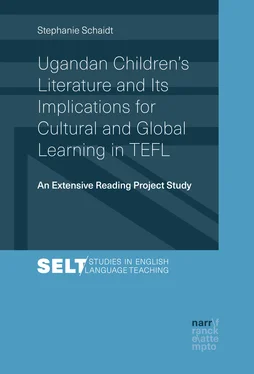1 ...7 8 9 11 12 13 ...34 Die Lernenden werden nicht einfach nach landeskundlicher Art über eine andere Kultur ‘belehrt’, sondern sie müssen sich ihr Bild von dieser Kultur selbst erabeiten. Dies geschieht durch die aktive Arbeit mit den in einem reader oder Materialpaket zur Verfügung stehenden oder aber mit selbst recherchierten Texten und Bildern – oder aus einer Kombination von beidem. [The learners are not just ‘instructed’ about another culture, but instead have to establish an image of this culture on their own. This happens through active work with texts and images that are available in a reader or material package or with personally researched texts and pictures – or with a combination of both.] (Ibid., my translation)
Furthermore, the two scholars suggest two different task types which may be used when working with texts and other materials representing a certain culture in the foreign language classroom: connective tasks and constructivist tasks (ibid. pp. 10–11). Whereas connective tasks prompt learners to establish connections beyond single texts with the aim of understanding one particular text in the light of another, constructivist tasks require students to do research on a certain topic and look for texts and other materials that in their opinion represent a specific culture. Here learning autonomy and reflection, characteristic features of constructivist approaches to learning, are focalised.
2.7 Implications of Anti-Racist Pedagogy
Alongside the constructivist approach to understanding otherness, ideas of anti-racist pedagogy (Elverich, Kalpaka, & Reindlmeier, 2009; Essed, 1991; Essed, Mullard, & Essinger, 1991; Kalpaka & Räthzel, 1990) promise to be very productive for cultural (and global learning). This pedagogic approach gained in importance in Germany in the 1990s (see Chapter 2.2). Since then, various contributions have been made in the field. Whereas in its beginning anti-racist pedagogy focused mainly on the people who are affected and excluded through racist structures and looked into ways in which they could be supported, in the last few years the privileges of the majority group are taken into account more strongly, particularly in the approach of Critical Whiteness (see Becker, 2011; Pech, 2009). The perspective from which racism is seen has, therefore, shifted: “ Gegenstand einer solchen Perspektive ist nicht das Objekt rassisierender Diskriminierung, sondern ihr Subjekt, der/die rassisierende Person. [The focus of such a perspective is not the object who is racially discriminated against but the subject, the person who is committing the act of racism]” (Dietze, 2006, p. 223; my translation). Furthermore, some scholars increasingly point to problematic aspects inherent in the concept of anti-racism as a counter-strategy and plead for a shift to an approach critical to racism ( rassismuskritischer Ansatz ) (Mecheril, 2004; Mecheril & Melter, 2010). Neither of the approaches that developed in the field are didactic in nature; they do offer, however, didactic implications. Before the key principles of approaches concerned with antiracism or critical of racism and the implications for cultural learning are elaborated on, the very complex concept ‘racism’ requires further clarification.
There are both broad and narrow definitions of racism. Whereas some narrow definitions focus on devaluations of human beings according to physical aspects only (biologically based racism), wider definitions also encompass other factors such as inferiority bias with reference to culture. Balibar (1991, p. 21) talks of “racism without races”. It is commonly agreed in anti-racism pedagogy and related approaches that to address the multifaceted nature of racism, a wider definition is required to draw on. A scholar who is frequently referred to in this context is Albert Memmi. For him racism is
a generalizing definition and valuation of differences, whether real or imaginary to the advantage of the one defining or deploying them [ accusateur ], and to the detriment of the one subjugated to the act of definition [ victime ], whose purpose is to justify (social or physical) hostility or assault [ aggression ]. (2000, p. 100)
Memmi therefore holds that racism comprises 1) the recognition of differences, real or imaginary, 2) the devaluation of ‘the other’ vs. self-valuation, 3) the application of a generalisation to a whole group and 4) a consequential justification for hostility towards ‘the other’ originating in its devaluation. Including a variety of aspects, this definition shows that ‘racism’ may have overlaps with phenomena such as ‘stereotypes’, ‘ethnocentrism’ and ‘xenophobia’.1 What is not explicitly manifested in this definition but forms a central element on which advocates of anti-racist pedagogy base their understanding of racism, is the prevalence of group hierarchies between the powerful and the powerless, majority and minority groups. Kalpaka and Räthzel (1990, p. 13) state that only when the group which constructs another group as inferior also has the power to enforce this construction, this may be referred to as racism.
Advocates of anti-racist pedagogy also repeatedly point out that racism is a process of social construction.
Racism is a system of structural inequalities and a historical process, both created and re-created through routine practices. […] structures of racism do not exist external to agents – they are made by agents – but specific practices are by definition racist only when they activate existing structural racial inequality in the system. (Essed, 1991, p. 39)
For them, racism is, therefore, more than attitudes and actions of individuals; it is embedded in institutional structures and social discourses.
Furthermore, embracing a wide definition, scholars of approaches critical to racism frequently describe exoticism as racism (see Danielzik & Bendix, 2011, p. 633) or deal with paternalism in the context of power asymmetries (see AG Sprache, Bildung und Rassismuskritik, 2012).
Experts in the field of anti-racist pedagogy criticise that in intercultural approaches social problems and inequalities are often considered to be grounded in culture and that it is believed that these problems may be overcome through intercultural encounters, changes of perspectives and tolerance. Those approaches exclude the existence of power asymmetries, racist structures and discrimination, the scholars argue:
In vielen Bildungsangeboten steht die Auseinandersetzung mit ‘kulturellen Differenzen’ im Mittelpunkt, die als Erklärungsmuster für Probleme des gesellschaftlichen Zusammenlebens dienen. Diese Sichtweise geht oftmals mit Kulturalisierungen einher und blendet gesellschaftliche Ausschließungspraxen und Machtverhältnisse aus. [Many educational programmes have at the centre the engagement with ‘cultural differences’ which serve as explanatory models for social conflicts. This often goes along with culturalisations and ignores exclusion practices by society and power asymmetries.] (Elverich & Reindlmeier, 2009, p. 34; my translation)
Anti-racist pedagogy focuses more on interventions on a structural than on an interpersonal level. It is rather concerned with societal-theoretical analyses than with deficit hypotheses, explanatory models of xenophobia, stereotypes or cultural conflicts (Müller, 1997, p. 363). A major aim of anti-racist pedagogy is “ ein aktives Bewußtsein für strukturelle Ähnlichkeiten, für Ungleichheit und Ungerechtigkeit zu entwickeln. [to develop an active awareness for structural similarities, inequality and injustice]” (Essed et al., 1991, p. 84; my translation).
Discussions in anti-racist pedagogy and related approaches offer various implications for the foreign language classroom. In the cross-curricular set of guidelines “ Rassismuskritischer Leitfaden [guideline critical to racism]” (Projekt Lern- und Erinnerungsort Afrikanisches Viertel (LEO) beim Amt für Weiterbildung und Kultur des Bezirksamtes Mitte von Berlin & Marmer, 2015), several ideas are given for the implementation of antiracism measures in the (foreign language) classroom. For one, the authors stress the importance of giving those who experience racism a voice, which should be also implemented in FLT by using more African and Black authors and sources as references (ibid., p. 27). Furthermore, perceiving racism as a social construct embedded in institutional structures and as a historical process, the scholars plead for a stronger contextualisation in educational work. The reflection upon power asymmetries and inequalities which are strongly linked to colonialism and imperialism requires more attention in the classroom, they argue. They consider this to apply to language teaching as well (ibid., pp. 28–29). In addition, the authors are concerned with a sensitive approach to language. They regard it as important that students reflect upon the power of language, learn about the origins of certain words and become exposed to self-determined denominations in any language learnt at school. The scholars emphasise that also language hegemonies of former colonial languages and the development of Creole languages require attention in this context (ibid., pp. 32–33).
Читать дальше












